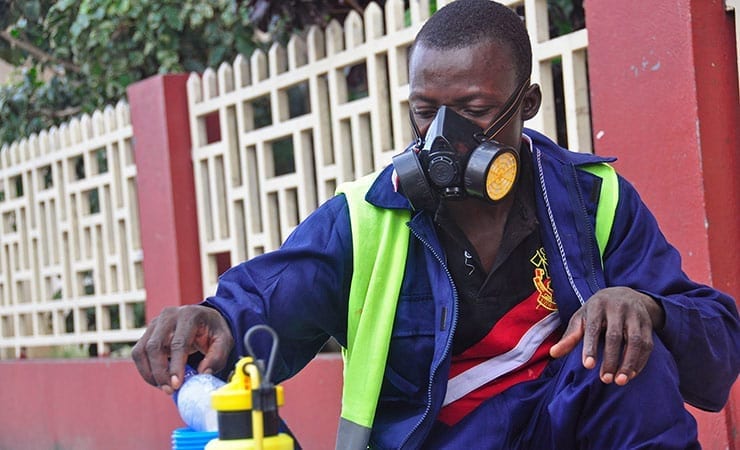Contributing author Heather Lander, Ph.D. provides insight into why implementing airborne precautions in the Ebola epidemic isn’t the right strategy to prevent infection of health care workers.

Recently, on ProMed, we saw a Professor in Hygiene and Infection Control put out a call for more stringent personal protective equipment (PPE) for the Ebola epidemic. He specifically called for the implementation of airborne protection as was used during the SARS outbreak in 2003.
While I can understand why he thinks this will help, he outlined it clearly in the email, I strongly believe this strategy will not only not work, but will make matters worse by directing efforts away from the real problem that is causing health care workers to get infected with Ebola in the first place.
Ebola is not airborne.[1;2] This we know. Laboratory experiments designed to study the potential of filoviruses as bioweapons have clearly shown that Ebola and Marburg are highly aerosol infectious.[3;4;5;6] However, there is absolutely no evidence that they are spread/transmitted by an airborne route and the preponderance of health care workers (HCW) getting infected is not because they are not protected against airborne Ebola, so implementing that kind of PPE won’t help.
Contact and droplet PPE are all that is needed for Ebola.[7;8] The problem is that HCW in this epidemic either don’t have PPE at all, only have some of it or have it, but are not properly trained in its use. In addition, there are not enough people for the work that needs to be done. But instead of quitting to get rest, food or relief from the extreme heat, these doctors and nurses are powering through, because they are looking into the eyes of those suffering, with no one else to turn to.
They need more people. They need more PPE. They need more training. To effectively prevent HCW from getting infected, these are the problems that must be addressed. Telling people that airborne precautions will prevent their infection will actually make this situation worse: they will rely on respirators and continue not using or misusing the PPE they actually need to protect themselves.
The SARS outbreak was, in general, a success in epidemic control, but the circumstances were strikingly different, and not only because of airborne precautions.[9] Airborne precautions were necessary because there is evidence that SARS can be spread by an airborne route, but there were many other factors such as a strong health care infrastructure and a population equipped with indoor plumbing, electricity and cell phones. These are apples and oranges.
If you want an outbreak from which to draw conclusions about how to prevent HCW infection with Ebola don’t look at SARS, look at the 1995 Kikwit Ebola outbreak. I discuss this at length in a recent blog post. Everything we need to know, we have learned.
The problem is not that we aren’t recommending the right PPE. The problem is the situation: no resources human or otherwise, no infrastructure, no training, and no hope in sight. But giving false hope by suggesting that respirators will prevent infection is irresponsible. I guarantee that if you say that the reason HCW are getting infected is because they are not implementing airborne precautions, then what they hear (and rightly so) is that airborne precautions alone will prevent infection.
Clearly, this is not the message we need to be sending to a population already failing catastrophically in proper PPE use. The fact that in her interview with Anderson Cooper, Nancy Writebol said she still doesn’t know how she got infected, clearly tells us what the real problem is. The people fighting this war need education on how Ebola is actually transmitted and how to effectively don and remove contact/droplet PPE so they can actually protect themselves. Unfortunately, without more people to help and more PPE to wear, no amount of education or training will help.
Heather Lander has a Ph.D. in Experimental Pathology with a concentration in arenavirus pathogenesis. She is the editor of Pathogen Perspectives, a blog providing insights on highly pathogenic biothreats. You can also reach her on Twitter @PathogenPhD or by email.
References
[1] J. Alimonti, A. Leung, S. Jones, J. Gren, X. Qiu, L. Fernando, B. Balcewich, G. Wong, U. Stroher, A. Grolla, J. Strong, and G. Kobinger, Evaluation of transmission risks associated with in vivo replication of several high containment pathogens in a biosafety level 4 laboratory. Sci. Rep. 4 (2014).
[2] D.G. Bausch, J.S. Towner, S.F. Dowell, F. Kaducu, M. Lukwiya, A. Sanchez, S.T. Nichol, T.G. Ksiazek, and P.E. Rollin, Assessment of the risk of Ebola virus transmission from bodily fluids and fomites. The Journal of infectious diseases 196 Suppl 2 (2007) S142-7.
[3] L. Borio, T. Inglesby, C.J. Peters, and et al., Hemorrhagic fever viruses as biological weapons: Medical and public health management. JAMA 287 (2002) 2391-2405.
[4] D.S. Reed, M.G. Lackemeyer, N.L. Garza, L.J. Sullivan, and D.K. Nichols, Aerosol exposure to Zaire ebolavirus in three nonhuman primate species: differences in disease course and clinical pathology. Microbes and Infection 13 (2011) 930-936.
[5] E.E. Zumbrun, A characterization of aerosolized Sudan virus infection in African green monkeys, cynomolgus macaques, and rhesus macaques. Viruses 4 (2012) 2115-2136.
[6] N.B. Bazhutin, [The effect of the methods for producing an experimental Marburg virus infection on the characteristics of the course of the disease in green monkeys]. Voprosy virusologiĭ 37 (1992) 153-156.
[7] S.F. Dowell, R. Mukunu, T.G. Ksiazek, A.S. Khan, P.E. Rollin, and C.J. Peters, Transmission of Ebola Hemorrhagic Fever: A Study of Risk Factors in Family Members, Kikwit, Democratic Republic of the Congo, 1995. Journal of Infectious Diseases 179 (1999) S87-S91.
[8] J.J. Muyembe-Tamfum, M. Kipasa, C. Kiyungu, and R. Colebunders, Ebola Outbreak in Kikwit, Democratic Republic of the Congo: Discovery and Control Measures. Journal of Infectious Diseases 179 (1999) S259-S262.
[9] M. Raponi, [Public health management of influenza and SARS in industrialized countries: strengths, weaknesses and future prospects as evaluated through Health Impact Assessment]. Igiene e sanità pubblica 68 (2012) 533-553.



